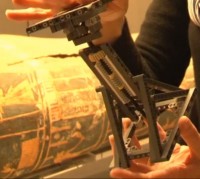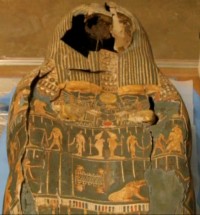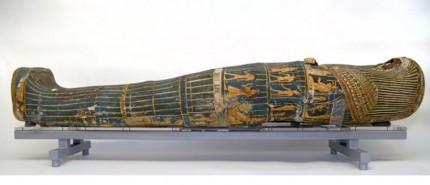 A 3000-year-old Egyptian mummy case which has been in the basement of Cambridge University’s Fitzwilliam Museum for almost 50 years has been restored to its former splendor using LEGO supports. Damage done in antiquity and deterioration since its discovery in the late 19th century had left the case cracking and caving in at the chest. Fitzwilliam conservators enlisted the aid of the university’s Department of Engineering to resolve the restoration challenges, and senior engineering student David Knowles enlisted the aid of LEGO.
A 3000-year-old Egyptian mummy case which has been in the basement of Cambridge University’s Fitzwilliam Museum for almost 50 years has been restored to its former splendor using LEGO supports. Damage done in antiquity and deterioration since its discovery in the late 19th century had left the case cracking and caving in at the chest. Fitzwilliam conservators enlisted the aid of the university’s Department of Engineering to resolve the restoration challenges, and senior engineering student David Knowles enlisted the aid of LEGO.
This mummy case was discovered in the Ramesseum, a mortuary temple of Pharaoh Ramesses the Great in the Theban necropolis across the Nile from modern Luxor, by Egyptologist James Quibell in 1896. Thieves had ripped out the gilded wood face panel and the mummy was gone. What remained was a brightly painted cartonnage case dating to the Third Intermediate Period (1069–664 B.C.).
Cartonnage is an Egyptian technique of layering strips of linen or papyrus with plaster or gum to make a thin, stable surface that can be easily shaped when wet and easily painted once dry. During the Third Intermediate Period, this technique was used to create mummy cases moulded to a mummy-shaped core which would be replaced with the real mummy once the case hardened. The cartonnage case would then be used as the innermost coffin inside a larger sarcophagus. The painting on the Fitzwilliam’s case featured scenes from the Egyptian Book of the Dead in an unusual dark blue/green color scheme and identified its former owner as Hor.
 The museum has been studying the Hor cartonnage case for years in the attempt to stabilize the piece sufficiently so it can be put back on display. In its early years at the museum, the case had unfortunately been exposed to excessive humidity, and as a result the torn perimeter around the looted face mask and the pectoral area had caved in. That put pressure on the rest of the case, causing long cracks in the cartonnage which threatened the entire structure as well as the surface painting.
The museum has been studying the Hor cartonnage case for years in the attempt to stabilize the piece sufficiently so it can be put back on display. In its early years at the museum, the case had unfortunately been exposed to excessive humidity, and as a result the torn perimeter around the looted face mask and the pectoral area had caved in. That put pressure on the rest of the case, causing long cracks in the cartonnage which threatened the entire structure as well as the surface painting.
Conservators knew they could de-stave the chest and face by softening the cartonnage with water and reshaping it, but they couldn’t wet the entire case since it could easily just collapse into itself, and even in small amounts the water could have damaged the painted surfaces they were trying to stabilize. They needed to have access to the case from the back through to the inside in order to keep the outer painted surface safe while they moistened the cartonnage in small sections and reshaped it at a snail’s pace. How to position the mummy case face downward in a safe, stable way that wouldn’t run the risk of worsening the structural problems and damaging the painting?
That was the conundrum they presented to the Department of Engineering, and the department opened the question as a final project for its seniors.
The challenge was taken up by David Knowles. In close consultation with the Fitzwilliam, David devised and made a frame to suspend Hor face-down while the reshaping was carried out. Using a combination of traditional wooden frames and mouldable materials designed for medical use, Hor could be completely supported for weeks at a time, allowing conservator Sophie Rowe to reshape the cartonnage very gradually.
The work wasn’t over yet. The case of Hor couldn’t be put on display in its ingenious but not visitor-friendly restoration frame and bandages. David Knowles got to work this time creating a display mount that would provide the proper support for the cartonnage case to rest on its back for people to see it. Once the display mount was done, he still needed to find a way to ensure that the chest wouldn’t collapse again just courtesy of gravity. Some kind of internal support that was firm enough to keep the chest in position but light enough not to put an additional weight and pressure burden on the structure was necessary.
 That’s when David had the brilliant idea of using LEGO. He built six lightweight, flexible LEGO lifts with an A-frame base, a central column of adjustable height and a top square of adjustable angle. All you need to change their height and angles is to screw them into position. To ensure the pointy angles of top and bottom don’t harm the cartonnage, conservators padded them with archival foam wherever they are in contact with it.
That’s when David had the brilliant idea of using LEGO. He built six lightweight, flexible LEGO lifts with an A-frame base, a central column of adjustable height and a top square of adjustable angle. All you need to change their height and angles is to screw them into position. To ensure the pointy angles of top and bottom don’t harm the cartonnage, conservators padded them with archival foam wherever they are in contact with it.
For this elegant and adorable solution, David Knowles won a well-earned prize from the engineering department. You can see the LEGO devices in movement in this video news story.

What would be funny is to have a giant minifig face peeking out where the mask should be.
:boogie: :hattip:
the fact that they can do this type of restoration work on something so old is remarkable. now if only they could do this for monuments like the parthenon and others.
They’ve done some excellent restoration work to Acropolis temple over the past few years, although LEGO was not involved. Sadly. 😉